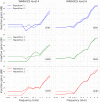OPRA-RS: A Hearing-Aid Fitting Method Based on Automatic Speech Recognition and Random Search
- PMID: 35264922
- PMCID: PMC8899657
- DOI: 10.3389/fnins.2022.779048
OPRA-RS: A Hearing-Aid Fitting Method Based on Automatic Speech Recognition and Random Search
Erratum in
-
Erratum: OPRA-RS: A hearing-aid fitting method based on automatic speech recognition and random search.Front Neurosci. 2022 Dec 9;16:1095750. doi: 10.3389/fnins.2022.1095750. eCollection 2022. Front Neurosci. 2022. PMID: 36570824 Free PMC article.
Abstract
Hearing-aid (HA) prescription rules (such as NAL-NL2, DSL-v5, and CAM2) are used by HA audiologists to define initial HA settings (e.g., insertion gains, IGs) for patients. This initial fitting is later individually adjusted for each patient to improve clinical outcomes in terms of speech intelligibility and listening comfort. During this fine-tuning stage, speech-intelligibility tests are often carried out with the patient to assess the benefits associated with different HA settings. As these tests tend to be time-consuming and performance on them depends on the patient's level of fatigue and familiarity with the test material, only a limited number of HA settings can be explored. Consequently, it is likely that a suboptimal fitting is used for the patient. Recent studies have shown that automatic speech recognition (ASR) can be used to predict the effects of IGs on speech intelligibility for patients with age-related hearing loss (ARHL). The aim of the present study was to extend this approach by optimizing, in addition to IGs, compression thresholds (CTs). However, increasing the number of parameters to be fitted increases exponentially the number of configurations to be assessed. To limit the number of HA settings to be tested, three random-search (RS) genetic algorithms were used. The resulting new HA fitting method, combining ASR and RS, is referred to as "objective prescription rule based on ASR and random search" (OPRA-RS). Optimal HA settings were computed for 12 audiograms, representing average and individual audiometric profiles typical for various levels of ARHL severity, and associated ASR performances were compared to those obtained with the settings recommended by CAM2. Each RS algorithm was run twice to assess its reliability. For all RS algorithms, ASR scores obtained with OPRA-RS were significantly higher than those associated with CAM2. Each RS algorithm converged on similar optimal HA settings across repetitions. However, significant differences were observed between RS algorithms in terms of maximum ASR performance and processing costs. These promising results open the way to the use of ASR and RS algorithms for the fine-tuning of HAs with potential speech-intelligibility benefits for the patient.
Keywords: age-related hearing loss (ARHL); automatic speech recognition (ASR); compression thresholds; hearing aids (HAs); insertion gains; prescription rule; random search (RS).
Copyright © 2022 Gonçalves Braz, Fontan, Pinquier, Stone and Füllgrabe.
Conflict of interest statement
This study is part of the development of a future product/service by Archean LABS intended for hearing-aid audiologists. CF acted as a scientific consultant. The remaining authors declare that the research was conducted in the absence of any commercial or financial relationships that could be construed as a potential conflict of interests.
Figures











Similar articles
-
Using Automatic Speech Recognition to Optimize Hearing-Aid Time Constants.Front Neurosci. 2022 Mar 17;16:779062. doi: 10.3389/fnins.2022.779062. eCollection 2022. Front Neurosci. 2022. PMID: 35368250 Free PMC article.
-
Erratum: OPRA-RS: A hearing-aid fitting method based on automatic speech recognition and random search.Front Neurosci. 2022 Dec 9;16:1095750. doi: 10.3389/fnins.2022.1095750. eCollection 2022. Front Neurosci. 2022. PMID: 36570824 Free PMC article.
-
An initial-fit comparison of two generic hearing aid prescriptive methods (NAL-NL2 and CAM2) to individuals having mild to moderately severe high-frequency hearing loss.J Am Acad Audiol. 2013 Feb;24(2):138-50. doi: 10.3766/jaaa.24.2.7. J Am Acad Audiol. 2013. PMID: 23357807 Clinical Trial.
-
How to Optimally Fit a Hearing Aid for Bimodal Cochlear Implant Users: A Systematic Review.Ear Hear. 2018 Nov/Dec;39(6):1039-1045. doi: 10.1097/AUD.0000000000000577. Ear Hear. 2018. PMID: 29688963
-
Factors in the Effective Use of Hearing Aids among Subjects with Age-Related Hearing Loss: A Systematic Review.J Clin Med. 2024 Jul 10;13(14):4027. doi: 10.3390/jcm13144027. J Clin Med. 2024. PMID: 39064066 Free PMC article. Review.
Cited by
-
Using Automatic Speech Recognition to Optimize Hearing-Aid Time Constants.Front Neurosci. 2022 Mar 17;16:779062. doi: 10.3389/fnins.2022.779062. eCollection 2022. Front Neurosci. 2022. PMID: 35368250 Free PMC article.
-
Automated Speech Audiometry: Can It Work Using Open-Source Pre-Trained Kaldi-NL Automatic Speech Recognition?Trends Hear. 2024 Jan-Dec;28:23312165241229057. doi: 10.1177/23312165241229057. Trends Hear. 2024. PMID: 38483979 Free PMC article.
-
Update on surgical and nonsurgical treatment options for age-related hearing loss.Z Gerontol Geriatr. 2023 Jul;56(4):276-282. doi: 10.1007/s00391-023-02182-3. Epub 2023 Apr 6. Z Gerontol Geriatr. 2023. PMID: 37022489 Review. English.
-
Automating Speech Audiometry in Quiet and in Noise Using a Deep Neural Network.Biology (Basel). 2025 Feb 12;14(2):191. doi: 10.3390/biology14020191. Biology (Basel). 2025. PMID: 40001959 Free PMC article.
References
-
- American National Standards Institute (1997). American National Standard: Methods for Calculation of the Speech Intelligibility Index. New York, NY: American National Standards Institute.
-
- Blum C., Roli A. (2001). Metaheuristics in combinatorial optimization: overview and conceptual comparison. ACM Comput. Surveys 35, 268–308. 10.1145/937503.937505 - DOI
-
- Cambridge Enterprise (2014). CAM2B-v2 [Software]. Cambridge: Cambridge Enterprise.
-
- Cruickshanks K. J., Nondahl D. M., Fischer M. E., Schubert C. R., Tweed T. S. (2020). A novel method for classifying hearing impairment in epidemiological studies of aging: the Wisconsin Age-Related hearing impairment classification scale. Am. J. Audiol. 29, 59–67. 10.1044/2019_AJA-19-00021 - DOI - PMC - PubMed
LinkOut - more resources
Full Text Sources
Research Materials

